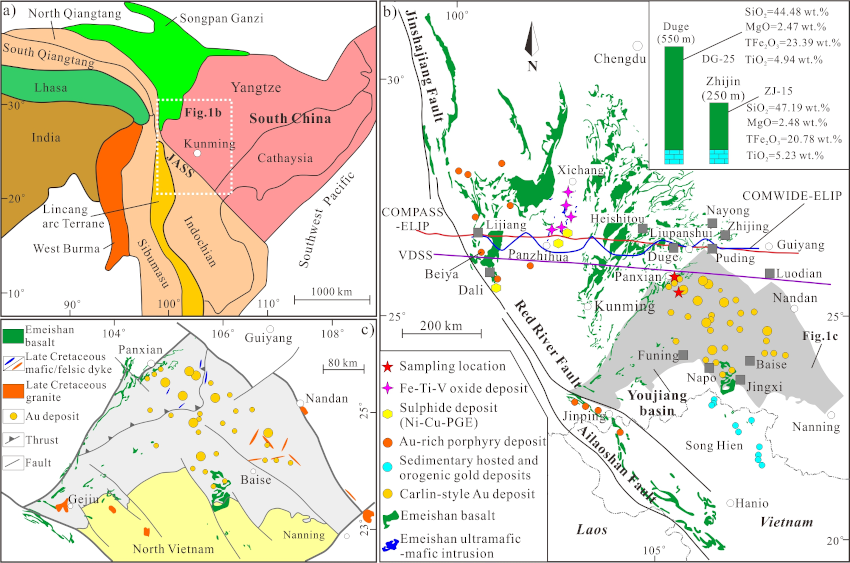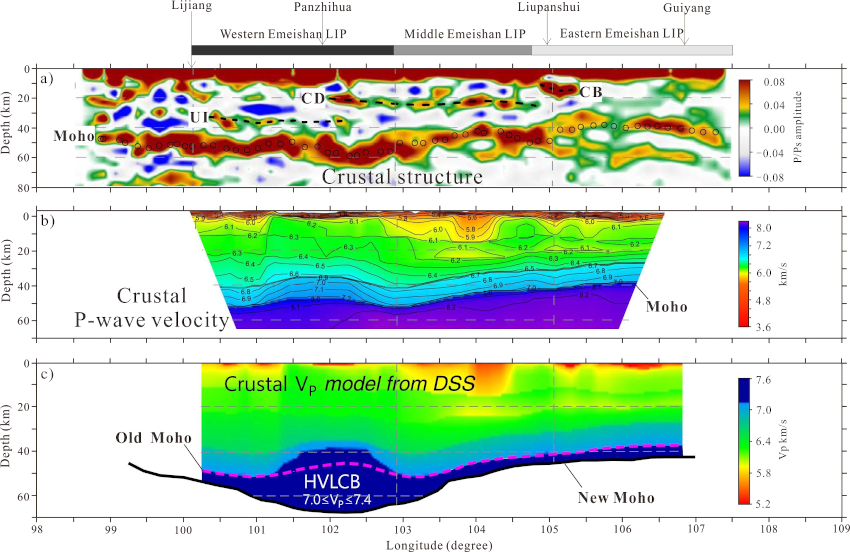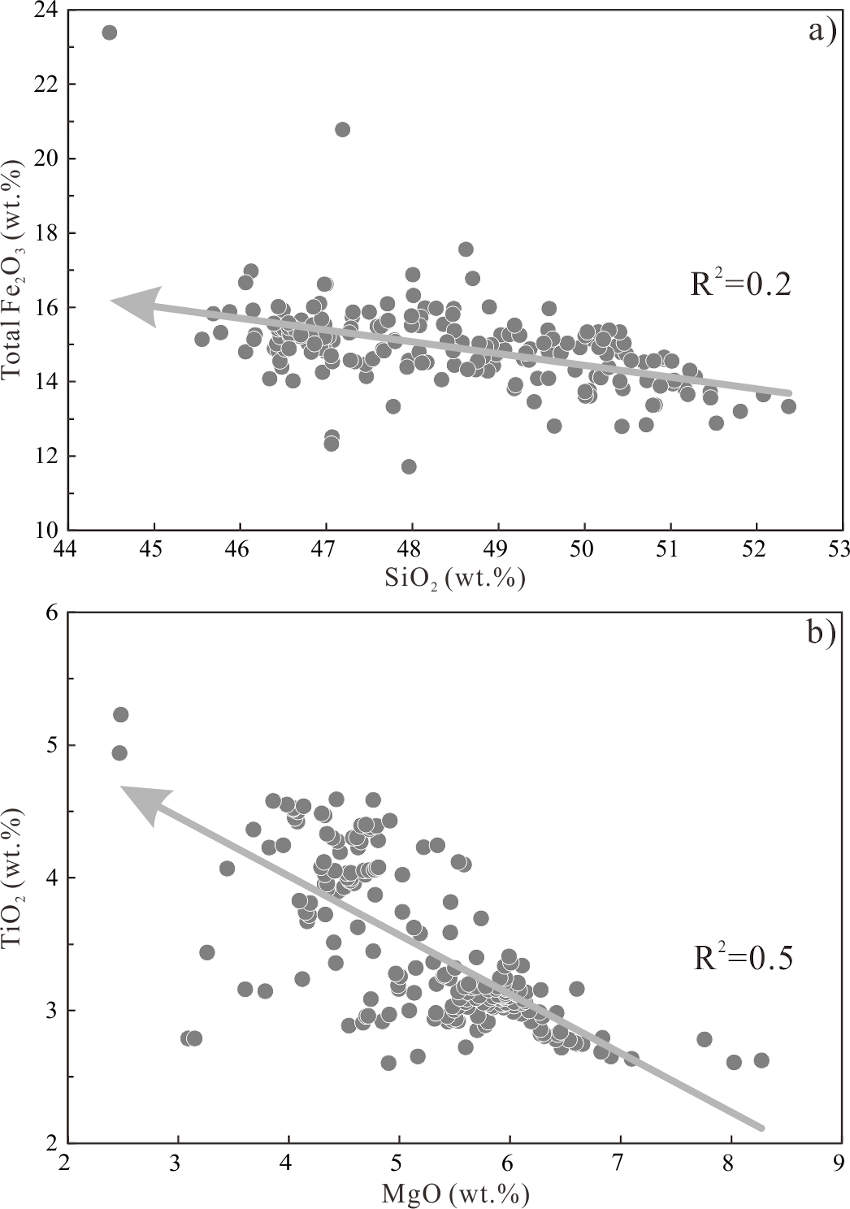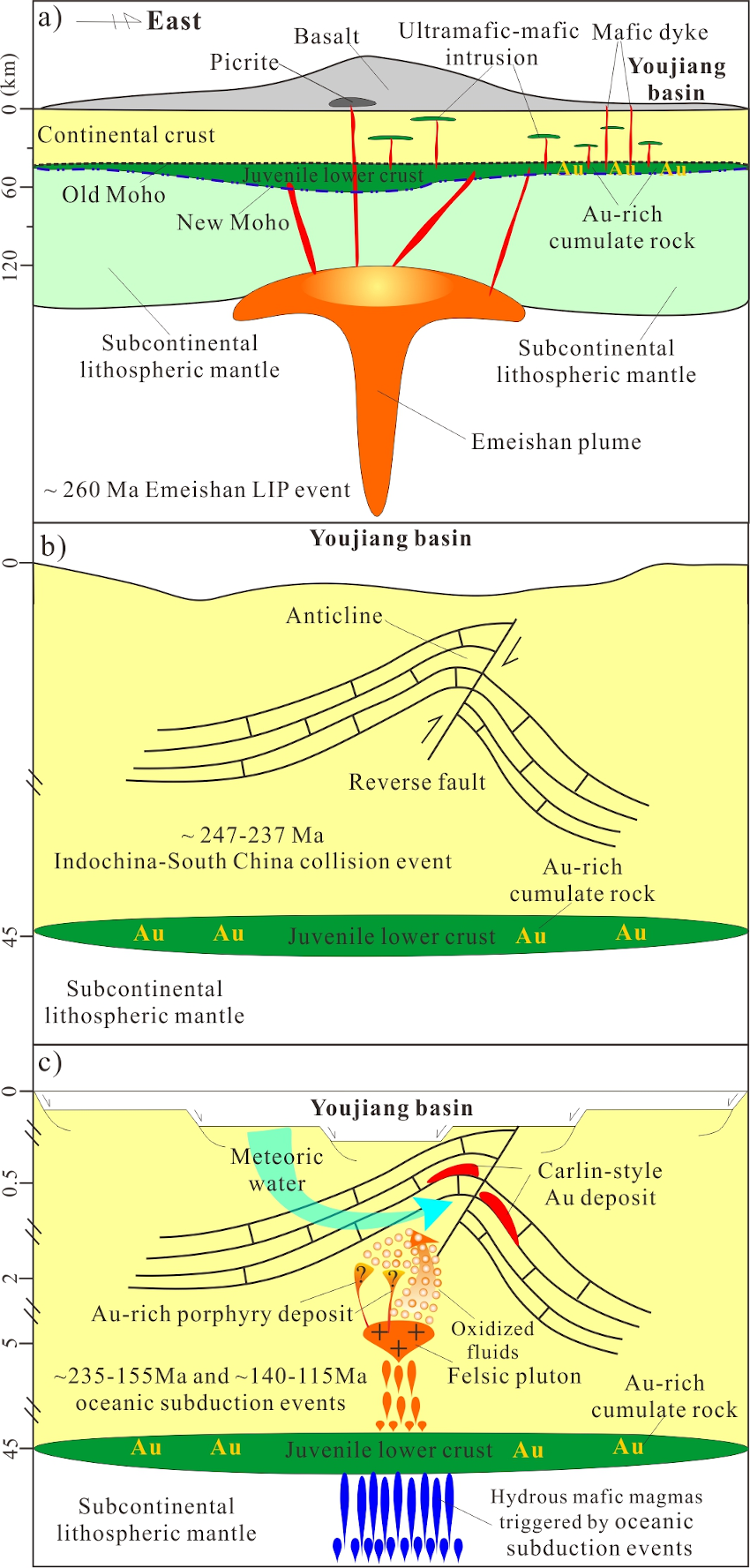January 2021 LIP of the Month
Carlin-style gold province linked to the Emeishan large igneous province
Jiang Zhu, Zhaochong Zhang, Ziliang Jin
State Key Laboratory of Geological Processes and Mineral Resources, China University of Geosciences, Beijing, 100083, China
Lead author email: zczhang@cugb.edu.cn
Figures, text and tables compiled from:
Zhu, J., Zhang, Z.C., Santosh, M., Jin, Z.L., 2020. Carlin-style gold province linked to the extinct Emeishan plume. Earth and Planetary Science Letters, 530, 115940. https://doi.org/10.1016/j.epsl.2019.115940.
Introduction
The Carlin-style gold deposits were defined as a new type after their discovery near Carlin in Nevada, USA during 1960s (e.g., Cline et al., 2005; Muntean and Cline, 2018; and references therein). Current Au endowment of Carlin-style deposits in Nevada is estimated up to 7,930 tons, and the deposits account for ~6% of the annual global production of Au, thus constituting the second largest auriferous province in the world (Muntean et al., 2011; Large et al., 2016; Muntean and Cline, 2018). The two popular genetic models for the Nevada-type deposits are: Au derived from metal-enriched sedimentary formations through meteoric or metamorphic water (Hofstra and Cline, 2000; Emsbo et al., 2003; Large et al., 2011) and origin through magmatic-hydrothermal activity in metasomatized subcontinental lithospheric mantle (SCLM) associated with oceanic subduction (Muntean et al., 2011; Large et al., 2016). Although some studies proposed a correlation between the Yellowstone mantle plume and Nevada’s Carlin-style Au deposits (Oppliger et al., 1997), this concept has not been widely accepted due to limited evidence. In general, mantle plumes as sources of heat and metals, have the potential to drive and contribute to a variety of giant magmatic and hydrothermal ore systems, such as magmatic Fe-Ti-V oxide, Ni-Cu-PGE (platinum group element) sulfide and Cr deposits hosted in mafic-ultramafic layered intrusions and hydrothermal IOCG (iron oxide-Cu-Au) as well as volcanogenic massive sulfide deposits in large igneous provinces (LIPs) (e.g., Ernst and Jowitt, 2013, 2017; Ernst, 2014).
Following the definition of the Carlin-style deposits of Nevada, similar ore deposits have been discovered in other parts of the world, such as in the Youjiang basin of China, Agdarreh and Zarshouran of Iran, Yukon of Canada and Sarawak of Malaysia (e.g., Muntean and Cline, 2018 and references therein). The Youjiang basin is the second largest province of Carlin-style Au deposits in the world after Nevada (e.g., Muntean and Cline, 2018), and is located within the Emeishan LIP of Yangtze craton in Southwest China. Previous geochronological data on hydrothermal minerals indicate that the Au deposits in this basin were formed at ~235-200 Ma and ~150-130 Ma (e.g., Hu et al., 2017), significantly later than the ~260 Ma Emeishan LIP. The magmatic underplate model suggests that the metal-bearing fluids driven off between ca. 30 and 100 Ma after the Emeishan LIP emplacement contributed to the formation Pb-Zn and native Cu ore deposit (Xu et al., 2014). However, it is difficult to generate extensive magmatic-hydrothermal fluids and related mineralization through the differentiation of basaltic magmas within a relatively short duration of several million years. According to traditional metallogenic concept there are no obvious direct or indirect genetic links between the Emeishan mantle plume and the Au deposits.
Overview of the Emeishan LIP
The ~260 Ma Emeishan LIP is located in the southwestern part of the Yangtze craton (Fig. 1), along the eastern margin of the Tibetan Plateau and northern Vietnam, and covers an area of over ~5×105 km2 (e.g., Shellnutt et al., 2014). The thickness of volcanic piles ranges from several hundred meters in the northern and eastern parts of this province to as much as ~5 km in the western-most outcrops (e.g., Zhu et al., 2018). The geophysical data suggest a ~15-20 km thick ultramafic-mafic layer in the western part and ~5-10 km thickness in central-eastern part at the base of the crust or above Moho (~50-40 km in depth) (Fig. 2) (Xu et al., 2015; Chen et al., 2015; Liu et al., 2017b). The major deformation and uplift in this region are associated with the Cenozoic India-Eurasian collision and Himalayan orogeny which resulted in strong erosion in the uplifted central zone, where many large-sized magmatic Fe-Ti-V oxide and middle-small sized Cu-Ni sulfide deposits are hosted in layered mafic-ultramafic intrusions in the Panzhihua-Xichang (Panxi) and Dali areas in the central Emeishan province (Fig. 1) (e.g., Shellnutt et al., 2014). Furthermore, a suite of Mesozoic-Cenozoic gold-rich porphyry deposits were discovered along the Jinshajiang-Ailaoshan suture within western margin and Jinping block of the Emeishan province (Fig. 1), attributed to an oceanic subduction of Mesozoic Paleo-Tethys or an east-west extension followed by the Cenozoic India-Asia collision (e.g., Hou et al., 2017). The Youjiang basin is located along the eastern part of the Emeishan LIP, and is also known as the Guizhou-Yunnan-Guangxi “Golden Triangle”, with more than 200 gold deposits including the world-class Shuiyingdong deposit (~265 tons Au), and a total proven reserve of >800 tons Au (Fig. 1) (Hu et al., 2017). Previous studies proposed a magmatic origin for the formation of the deposits in the basin based on isotopic data from hydrothermal minerals. These include the δ34S range of -2.6‰ to +5.3‰ on ore-stage pyrite at the Shuiyingdong Au deposit (e.g., Tan et al, 2015; Hou et al., 2016). The calcites of the ore-forming stage from several Au deposits including Shuiyingdong have δ13C values ranging from -3‰ to -9‰ (e.g., Tan et al., 2015). These isotope compositions are very close to those of mantle sulfur (0 ± 3‰) and carbon (-3‰ to -8‰), indicating a deep magmatic source (Hu et al., 2017). Furthermore, the Au-bearing rims of zoned pyrite grains in the Lannigou deposit are characterized by highly variable δ34S values of 1.1‰ to 18.1‰, inconsistent with the δ34S range of 10‰ to 14‰ from calcareous host rocks, suggesting that the Au-bearing fluids were of magmatic origin with mantle-like δ34S value (~0‰) (Yan et al., 2018).

Fig. 1. Simplified tectonic and geological maps for the Yangtze craton, Emeishan LIP and Youjiang basin. (a) Distribution of principal continental blocks, arc terranes and sutures in eastern Asia showing the location of Yangtze craton (Metcalfe, 2013). The JASS represents Jinshajiang-Ailaoshan-Song Ma suture. (b) Simplified geological map of the Emeishan LIP showing spatial distributions for erupted flood basalts (revised from Shellnutt, 2014) and Youjiang basin. Data of Duge and Zhijing sections are from Xu et al. (2003). The red, blue and purple solid lines indicate locations of COMPASS-ELIP seismic array (Chen et al., 2015), COMWIDE-ELIP experiment (Xu et al., 2015) and virtual deep seismic sounding (VDSS) profile (Liu et al., 2017b) respectively, and these geophysical profiles are given in Fig. 2). (c) Simplified geological map of the Youjiang basin showing Calin-style Au deposits, ~260 Ma Emeishan basalts, ~90-80 Ma mafic/ felsic dykes and ~100-80 Ma granites (revised from Zhu et al., 2017). Mesozoic-Cenozoic Au-rich porphyry deposits along the Jinshajiang-Ailaoshan suture and within Jinping block are based on Hou et al. (2017). Sedimentary hosted and orogenic gold deposits of ~210-185 Ma at Song Hien area of northern Vietnam are taken from Nevolko et al. (2017). Large to super-large and medium to small Carlin-style Au deposits are shown as golden larger and smaller solid dots in Figs. 1b and 1c. Grey solid squares show the locations for compiled published whole-rock data of the picrites and mafic rocks, including Lijiang and Dali (picrites), Funning and Luodian (mafic dykes) and the others (basalts) in Fig. 1b.

Fig. 2. Multidisciplinary geophysical observations on the Emeishan LIP. (a) Crustal structure based on the teleseismic P-wave receiver functions (Chen et al., 2015). The CB, CD and UI represent crystalline basement, Conrad discontinuity, and underplating interface, respectively. (b) Crustal P-wave velocity derived from the COMWIDE-ELIP experiment (Xu et al., 2015). (c) Crustal P-wave velocity structure obtained from the VDSS (virtual deep seismic sounding) (Liu et al., 2017b). The high-velocity lower crustal body is abbreviated as HVLCB. Their locations of profiles are shown in Fig. 1.
Gold enrichment and remobilization in juvenile lower crust
Our results combined with the multidisciplinary geophysical investigations indicate that cumulate rocks of > 5 km thickness formed by high degree of fractional crystallization (~80-95 wt.%, Fig. 3) of plume-derived magmas were emplaced at ~50-40 km in depths beneath the Youjiang basin. The bulk-rock geochemical signature of basalts from the eastern Emeishan province displays Fe-rich and Si-poor evolution (Fig. 4), indicating a Fenner trend in the deep magma chamber. Petrographic observations show that the phenocrysts in the basalts from the eastern Emeishan province are dominantly plagioclase and that all the Fe-Ti oxides are hosted in the matrix (Hou et al., 2011, Liao et al., 2012). These geochemical and petrographic features suggest that the early stage of magma evolution occurred at a low oxygen fugacity and H2O-poor environment beneath the eastern Emeishan LIP, which delayed the onset of magnetite crystallization and promoted Fe-enrichment in magmas at the late stage. These features demonstrate that early stage of magma evolution occurred at low oxygen fugacity and sulfide saturation, which is favorable for the enrichment of chalcophile elements within the cumulate rocks beneath the eastern Emeishan province. At the Jinbaoshan Pt-Pd sulfide deposits in the central part of the Emeishan province, several primary grains of native gold and platinum-group minerals were reported in the sulfide-bearing mineralized wehrlites (Tao et al., 2007), providing direct evidence for Au enrichment in the deep cumulate rocks. More importantly, pure native Au blebs (30 μm) were found enclosed within fresh olivine phenocrysts from picritic lavas, which also carry native copper grains and moissanite (SiC) (Zhang et al., 2006). All this evidence supports the crystallization of native Au from the Emeishan plume-derived magmas at low oxygen fugacity during the early stage within the cumulate rocks. Therefore, we speculate that the massive cumulate rocks at the base of the crust beneath the eastern Emeishan province, as revealed by geophysical data, might be enriched in Au, forming a potential Au reservoir.

Fig. 3. Modeled compositions and mass percentage of residual liquid from the primary Emeishan plume-derived magmas at constant pressure (1.6, 1.2, 0.8, 0.4, 0.2 and 0.1 GPa) and oxygen fugacity of ΔFMQ = -1. (a) Plots of SiO2 versus MgO for basaltic rocks of the eastern Emeishan province within diagrams modeled residual liquids formed by equilibrium crystallization. (b) Modeled residual liquid versus temperature at constant pressure. Gray-shaded area indicates an average range for mass percentage of residual liquid. Modeled residual liquids formed by equilibrium crystallization of dry primary picrites at constant pressure (1.6, 1.2, 0.8, 0.4, 0.2 and 0.1 GPa). Small open circles on the curves represent 20 ?C temperature intervals. The oxides are normalized to 100% on a volatile-free basis.

Fig. 4. Plots of total Fe2O3 versus SiO2 and TiO2 versus MgO for basaltic rocks in eastern part of the Emeishan LIP. See Table S2 for a compilation based on the Georoc database (http://georoc.mpch-mainz.gwdg.de/georoc/). Nineteen samples with TiO2 < 2.5 wt.% were filtered from the 224 compiled samples. (a) Plots of total Fe2O3 versus SiO2. (b) Plots of TiO2 versus MgO. The oxides are normalized to 100% on a volatile-free basis.
The high B/Sr ratios of fluid inclusions from the world-class Shuiyingdong ore field in the Youjiang basin (Su et al., 2009) are consistent with those of typical porphyry deposits (Large et al., 2016). Geophysical investigations reveal that this ore field lies above a felsic pluton ~5 km below the surface (Xie et al., 2018). Fluid inclusions from the Shuiyindong and Yata Au deposits contain significant amount of CO2 and are estimated to have formed at depths of ca. 4-6 km (Su et al., 2009). This is consistent with the emplacement depth of the felsic pluton as revealed from geophysical investigations. Moreover, sulfur and carbon isotopic data from ore-stage pyrite and calcite also suggest a deep magmatic or mantle-like origin for Au deposits in the Youjiang basin (Hu et al., 2017; Yan et al., 2018). Taken together, we conclude that the ore-forming fluids are characterized by mantle-like origin and significantly oxidized in the Youjiang basin, and were evolved from magmatic (mantle-like) magmas, similar to that of porphyry deposits. It has been proposed that flat subduction of the Paleo-Pacific slab occurred beneath the South China Block over a region of 1000 km during the Middle Triassic to the Middle Jurassic (~235-155 Ma) (Li and Li, 2007). Another flat subduction of the Cretaceous Neo-Tethyan slab reached up to the Ailaoshan suture (Liu et al., 2017a), both suggesting that the Youjiang basin was located in a back-arc setting. Recent studies on the Cretaceous igneous rocks of ca. 140-115 Ma within the Ailaoshan suture, close to the Youjiang basin, indicate that they formed in a back-arc extension setting associated with the Neo-Tethyan oceanic subduction (Liu et al., 2017a), which is coupled with the later ore-forming stage (~150-130 Ma) in the Youjiang basin.
In conjunction with the geological framework in the Youjiang basin, we propose the following model for the formation and remobilization of Au-rich crustal magmatic underplate. (i) The primary Emeishan plume-derived magmas (~260 Ma), underwent high degrees of fractional crystallization, and generated massive Au-rich cumulate rocks at the base of the crust beneath the basin. (ii) The favorable ore-controlling systems, reverse fault on the flank of anticline (dome) or anticline (dome), were formed during the Indochina-China continental collision event (~247-237 Ma). (iii) The back-arc extensions and oxidized fluids associated with multiple oceanic subduction events (~ 235-155 Ma and ~140-115 Ma) triggered the melting of enriched juvenile lower crust, and contributed to the formation of Au-rich felsic magmas by oxidized fluids into the upper crust. (iv) The Au-rich magmatic fluids were released from felsic plutons, transported into shallow crust, mixed with meteoric water and ultimately precipitated within the favorable ore-controlling systems generated by continental collision event (Fig. 5).

Fig. 5. Schematic model for the formation of enriched juvenile lower crust and its relationship with the Carlin-style gold deposits. (a) Au-rich juvenile lower crust evolved from the primary plume-derived magmas. (b) The favorable ore-controlling systems were associated with the continental collision event. (c) Oceanic subduction events triggered remobilization of Au-rich juvenile lower crust. Ages of Indochina-China collision and Paleo-Pacific and Neo-Tethyan oceanic subduction events are from Wang et al. (2018), Li and Li (2007) and Liu et al. (2017a).
Summary
Overall, our study raises the possibility of a potential Au reservoir in the crustal magmatic underplate that provided the ore-forming materials for the formation of large-scale Carlin-style Au province and other types of Au deposits in the Youjiang basin in the Emeishan and other LIPs. Our work modeled on the basis of the Emeishan LIP has important implications in formulating new concepts on metallogeny associated with mantle plume, and also offers new insights into the formation of large auriferous province within stable cratonic interior.
References
Chen, Y., Xu, Y.G, Xu, T., Si, S.K., Liang, X., Tian, X.F., Tian, X.B., Deng, Y.F., Chen, L., Wang, P., Xu, Y.H., Lan, H.Q., Xiao, F.H., Li, W., Zhang, X., Yuan, X.H., Badal, J., Teng, J.W., 2015. Magmatic underplating and crustal growth in the Emeishan Large Igneous Province, SW China, revealed by a passive seismic experiment. Earth and Planetary Science Letters, 432, 103-114. https://doi.org/10.1016/j.epsl.2015.09.048.
Cline, J.S., Hofstra, A.H., Muntean, J.L., Tosdal, R.M., Hickey, K.A., 2005. Carlin-type gold deposits in Nevada, USA: Critical geologic characteristics and viable models. Economic Geology, 100th Anniversary Volume, 451-484.
Emsbo, P., Hofstra, A.H., Lauha, E.A., Griffin, G.L., Hutchinson R.W., 2003. Origin of high-grade gold ore, source of ore fluid components, and genesis of the Meikle and neighboring Carlin-type deposits, northern Carlin trend, Nevada. Economic Geology, 98, 1069-1100. https://doi.org/10.2113/gsecongeo.98.6.1069.
Ernst, R.E., 2014. Large Igneous Provinces: Cambridge. Cambridge University Press, pp. 1-653.
Ernst, R.E., Jowitt, S.M., 2013. Large Igneous Provinces (LIPs) and metallogeny. In: Colpron, M., Bissig, T., Rusk, B.G., Thompson, J.F.H. (Eds.), Tectonics, Metallogeny, and Discovery: The North American Cordillera and Similar Accretionary Settings. In: Society Economic Geologists Special Publication, vol. 17, pp.17-51.
Ernst, R.E., Jowitt, S.M., 2017. Multi-commodity, multi-scale exploration targeting using the Large Igneous Province record. In: Wyche, S. and Witt, W.K. (Eds.) TARGET 2017, Perth, Australia: Abstracts. Geological Survey of Western Australia, Record 2017/6, p. 41-44.
Hofstra, A.H., Cline, J.S., 2000, Characteristics and models for Carlin-type gold deposits. Reviews in Economic Geology, 13, 163-220.
Hou, T., Zhang, Z.C., Kusky, T., Du, Y.S., Liu, J.L., Zhao, Z.D., 2011. A reappraisal of the high-Ti and low-Ti classification of basalts and petrogenetic linkage between basalts and mafic–ultramafic intrusions in the Emeishan Large Igneous Province, SW China. Ore Geology Reviews, 41(1), 133-143. https://doi.org/10.1016/j.oregeorev.2011.07.005.
Hou, Z.Q., Zhou, Y., Wang, R., Zheng, Y.C., He, W.Y., Zhao, M., Evans, N.J., Weinberg, R. F., 2017. Recycling of metal-fertilized lower continental crust: Origin of non-arc Au-rich porphyry deposits at cratonic edges. Geology, 45(6), 563-566. https://doi.org/10.1130/G38619.1.
Hu, R.Z., Fu, S.L., Huang, Y., Zhou, M.F., Fu, S.H., Zhao, C.H., Wang, Y.J., Bi, X.W., Xiao, J.F., 2017.The giant South China Mesozoic low-temperature metallogenic domain: Reviews and a new geodynamic model. Journal of Asian Earth Sciences, 137, 9-34. https://doi.org/10.1016/j.jseaes.2016.10.016.
Large, R.R., Bull, S.W., Maslennikov, V.V., 2011. A carbonaceous sedimentary source-rock model for Carlin-type and orogenic gold deposits. Economic Geology, 106, 331-358 (2011). https://doi.org/10.2113/econgeo.106.3.331.
Large, S.J., Bakker, E.Y., Weis, P., Wälle, M., Ressel, M., Heinrich, C.A., 2016. Trace elements in fluid inclusions of sediment-hosted gold deposits indicate a magmatic-hydrothermal origin of the Carlin ore trend. Geology, 44(12), 1015-1018. https://doi.org/10.1130/G38351.1.
Li, Z.X., Li, X.H., 2007. Formation of the 1300-km-wide intracontinental orogen and postorogenic magmatic province in Mesozoic South China: a flat-slab subduction model. Geology, 35(2), 179-182. https://doi.org/10.1130/G23193A.1.
Liao, B.L., Zhang, Z.C., Kou, C.H., and Li. H.B., 2012. Geochemistry of the Shuicheng Permian sodium trachybasalts in Guizhou Province and constraints on the mantle sources. Acta Petrologica Sinica, 28(4), 1238-1250 (in Chinese with English abstract).
Liu, H.C., Wang, Y.J., Cawood, P.A., Guo, X.F., 2017a. Episodic slab rollback and back-arc extension in the Yunnan-Burma region: Insights from Cretaceous Nb-enriched and oceanic-island basalt-like mafic rocks. Geological Society of America Bulletin, 129(5-6), 698-714. https://doi.org/10.1130/B31604.1.
Liu, Z., Tian, X.B., Chen, Y., Xu, T., Bai, Z.M., Liang, X.F., Iqbal, J., Xu, Y., 2017b. Unusually thickened crust beneath the Emeishan large igneous province detected by virtual deep seismic sounding. Tectonophysics, 721, 387-394. https://doi.org/10.1016/j.tecto.2017.10.009.
Metcalfe, I., 2013. Gondwana dispersion and Asian accretion: tectonic and palaeogeographic evolution of eastern Tethys. Journal of Asian Earth Sciences, 66, 1-33. https://doi.org/10.1016/j.jseaes.2012.12.020.
Muntean, J.L., Cline, J.S., 2018. Diversity of Carlin-style gold deposits. Reviews in Economic Geology, 20, 1-6.
Muntean, J.L., Cline, J.S., Simon, A.C., and Longo, A.A., 2011. Magmatic-hydrothermal origin of Nevada’s Carlin-type gold deposits. Nature Geoscience, 4, 122-127. https://doi.10.1038/NGEO1064.
Nevolko, P.A., Tran, T.H., Yudin, D.S., Ngo, T.P., 2017. Ar-Ar ages of gold deposits in the Song Hien domain (NE Vietnam): Tectonic settings and comparison with Golden Triangle in China in terms of a single metallogenic province. Ore Geology Reviews, 89, 544-556. https://doi.org/10.1016/j.oregeorev.2017.07.004.
Oppliger, G.L., Murphy, J.B., Brimhall Jr., G.H., 1997. Is the ancestral Yellowstone hotspot responsible for the Tertiary “Carlin” mineralization in the Great Basin of Nevada? Geology, 25, 627-630. http://dx.doi.org/10.1130/0091-7613(1997)025<0627:ITAYHR>2.3.CO;2.
Shellnutt, J.G., 2014. The Emeishan large igneous province: A synthesis. Geoscience Frontiers, 5(3), 369-394. https://doi.org/10.1016/j.gsf.2013.07.003.
Su, W.C., Heinrich, C.A., Pettke, T., Zhang, X.C., Hu, R.Z., Xia, B., 2009a. Sediment hosted gold deposits in Guizhou, China: Products of wall-rock sulfidation by deep crustal fluids. Economic Geology, 104, 73-93. https://doi.org/10.2113/gsecongeo.104.1.73.
Tan, Q.P., Xia, Y., Xie, Z.J., Yan, J., Wei, D.T., 2015. S, C, O, H, and Pb isotopic studies for the Shuiyindong Carlin-type gold deposit, Southwest Guizhou, China: Constraints for ore genesis. Chinese Journal of Geochemistry, 34(4), 525-539. https://doi.org/10.1007/s11631-015-0063-5
Tao, Y., Li, C.S., Hu, R.H., Ripley, E.M., Du, A.D., Zhong, H., 2007. Petrogenesis of the Pt-Pd mineralized Jinbaoshan ultramafic intrusion in the Permian Emeishan large igneous province, SW China. Contributions to Mineralogy and Petrology, 153(3), 321-337. https://doi:10.1007/s00410-006-0149-5.
Wang, Y.J., Qian, X., Cawood, P.A., Liu, H.C., Feng, Q.L., Zhao, G.C., Zhang, Y.H., He, H.Y., Zhang, P.Z., 2018. Closure of the East Paleotethyan Ocean and amalgamation of the Eastern Cimmerian and Southeast Asia continental fragments. Earth-Science Reviews, 186, 195-230. https://doi.org/10.1016/j.earscirev.2017.09.013.
Xie, Z.J., Xia, Y., Cline, J.S., Pribil, M.J., Koenig, A., Tan, Q.P., Wei, D.T., Wang, Z.P., Yan, J., 2018. Magmatic Origin for Sediment-Hosted Au Deposits, Guizhou Province, China: In Situ Chemistry and Sulfur Isotope Composition of Pyrites, Shuiyindong and Jinfeng Deposits. Economic Geology, 113(7), 1627-1652. https://doi.org/10.5382/econgeo.2018.4607.
Xu, T., Zhang, Z.J., Liu, B.F., Chen, Y., Zhang, M.H., Tian, X.B., Xu, Y.G., Teng, J.W., 2015. Crustal velocity structure in the Emeishan large igneous province and evidence of the Permian mantle plume activity. Science China-Earth Sciences, 58(7), 1133-1147. https://doi.org/10.1007/s11430-015-5094-6.
Xu, Y.G., Mei, H.J., Xu, J.F., Huang, X.L., Wang, Y.J., Chung, S.L., 2003. Origin of two differentiation trends in the Emeishan flood basalts. Chinese Science Bulletin, 48(4), 390-394. https://doi.org/10.1007/BF03183236.
Xu, Y.K., Huang, Z.L., Zhu, D., Luo, T.Y., 2014. Origin of hydrothermal deposits related to the Emeishan magmatism. Ore Geology Reviews, 63, 1-8. https://doi.org/10.1016/j.oregeorev.2014.04.010.
Yan, J., Hu, R.Z., Liu, S., Lin, Y.T., Zhang, J.C., Fu, S.L., 2018. NanoSIMS element mapping and sulfur isotope analysis of Au-bearing pyrite from Lannigou Carlin-type Au deposit in SW China: New insights into the origin and evolution of Au-bearing fluids. Ore Geology Reviews, 92, 29-41. https://doi.org/10.1016/j.oregeorev.2017.10.015.
Zhang, Z.C., Mao, J.W., Wang, F.S., Pirajno, F., 2006b. Native Au and native copper grains enclosed by olivine phenocrysts in a picrite lava of the Emeishan large province, SW China. American Mineralogist, 91, 1178-1183. https://doi.org/10.2138/am.2006.1888.
Zhu, J., Zhang, Z.C., Reichow, M.K., Li, H.B., Cai, W.C., Pan, R.H., 2018. Weak vertical surface movement caused by the ascent of the Emeishan mantle anomaly. Journal of Geophysical Research-Solid Earth, 123(2), 1018-1034. https://doi.org/10.1002/2017JB015058.
Zhu, J.J., Hu, R.Z., Richards, J.P., Bi, X.W., Stern, R., Lu, G., 2017. No genetic link between Late Cretaceous felsic dikes and Carlin-type Au deposits in the Youjiang basin, Southwest China. Ore Geology Reviews, 84, 328-337. https://doi.org/10.1016/j.oregeorev.2017.01.014.
